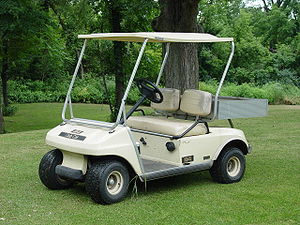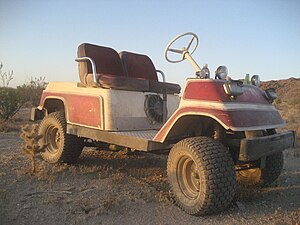Golf cart
- Golf car redirects here. For the compact passenger car, see Volkswagen Golf



A golf cart (called golf car in ANSI standard Z130.1, since "carts" are not self-propelled)[1] is a small vehicle designed originally to carry two golfers and their golf clubs around a golf course or on desert trails with less effort than walking.
Golf cars come in a wide range of formats and are more generally used to convey small numbers of passengers short distances at speeds less than 15 mph (24 km/h) per ANSI Standard z130.1 as originally manufactured. They are generally around 4 feet (1.2 m) wide × 8 feet (2.4 m) long × high and weigh 900 pounds (410 kg) to 1,000 pounds (450 kg). Most are powered by 4-stroke engines.
The price of a golf car can range anywhere from $3,000 - $15,000 per car, depending on several factors. These factors may include whether or not a fleet of cars is being purchased for a golf course or a country club, for example, and whether the cars are new or used. Other factors may include options such as equipment requirements, and how many people the car is meant to transport. With the rise in popularity of golf carts, many golf clubs or country clubs offer storage and energy options to golf cart owners. This has led to the modification of golf carts to suit use at the particular golf course. Typical modification includes windshields, ball cleaners, cooler trays, upgraded motor or speed controller (to increase speed and/or torque), and lift kits.
Originally golf cars were electrically powered, but in time gasoline-powered variants started to occur. Electric golf cars were the first mass-produced electric vehicles for private consumer use. This variety is now used in many communities where their lack of pollutants, lack of noise, and safety for pedestrians and other cars (due to slow speeds) are beneficial. When purpose-built for general transportation these are called Neighborhood Electric Vehicles (NEVs), but with various operating limitations such as top speed and heavy regulation on which type of streets these types of cars are permitted to be used. These may resemble the golf cars shown above, although some are now being made with all–weather car–like bodies.
The minimum age to drive a golf cart is 13 in Alabama, California, Iowa, Kansas, Kentucky, Rhode Island, and Vermont. In Florida, the minimum age is 14. In all the other states, the minimum age is 15.
History
Reportedly, the first use of a motorized cart on a golf course was by JK Wadley of Texarkana, Texas/Arkansas, who saw a three-wheeled electric cart being used in Los Angeles to transport senior citizens to the grocery store. Later, he purchased a cart and found that it worked terrible on a golf course.[2] The first electric golf cart was custom made in 1932, but did not gain widespread acceptance.[3] In the 1930s till the 1950s the most wide spread use of Golf Carts were for those with disabilities who could not walk far.[4] But electric golf cars have been used since at least 1952. Merle Williams of Long Beach, California was an early innovator of the electric golf car.[citation needed] He started with knowledge gained from production of electric cars due to World War II gasoline rationing. In 1951 his Marketeer Company began production of an electric golf car in Redlands, California. Cushman began production in 1955, Club Car in 1958, Taylor-Dunn in 1961, Harley-Davidson in 1963, Yamaha Golf Car in 1979 and CT&T in 2002.

Golf cart communities
Peachtree City, Georgia has many miles of golf car paths that link the city together. Golf cart travel is used by a great majority of the community, especially among high school students. McIntosh High School even has a student golf cart parking lot on campus.
On islands (such as Santa Catalina Island, California, Bald Head Island, North Captiva Island, North Carolina, and Hamilton Island), motor vehicles are sometimes restricted and residents use golf cars instead.
The Villages, Florida, a retirement community of over 70,000 people, has an extensive golf cart trail system (estimated at around 100 miles (160 km)) and also allows golf carts on many streets. It is the most popular form of transportation in this community.
On the tropical islands of Belize golf carts are a major form of road transport and can be rented by tourists.
The residential community of Discovery Bay, Hong Kong does not allow the use of private vehicles apart from a fleet of 520 Golf Carts (excluding the ones operating exclusively in the Golf or the Marina Clubs). The remainder of the 20,000 residents rely on a mixture of shuttle buses and hire cars to travel around the township.
Accidents and injuries
Along with the rising popularity of golf carts, the number of golf cart-related injuries has increased significantly over the last decade. A study conducted by researchers in the Center for Injury Research and Policy of The Research Institute at the Nationwide Children's Hospital found that the number of golf cart-related injuries rose 132% during the 17-year study period. According to the study, published in the July 2008 issue of the American Journal of Preventive Medicine, there were an estimated 148,000 golf cart-related injuries between 1990 and 2006, ranging from an estimated 5,770 cases in 1990 to approximately 13,411 cases in 2006. More than 30% of golf cart-related injuries involved children under the age of 16.[5]
The most common type of injury was soft tissue damage, usually just bruises, followed by fractures, constituting 22.3% of the cases, and lacerations, accounting for 15.5% of injuries.[6] Other types of injuries include concussions, internal injuries, subdural hematoma, spinal cord injury, or acute respiratory compromise. While rare, a few cases had severe outcomes: 4 fatalities, 2 paraplegic, and 1 quadriplegic injuries have been documented.[7]
Some of the main causes of injury related to golf cart accidents included cart overturn, falling/jumping from a moving golf cart, collision with another vehicle or stationary object, struck/run over by a cart, getting into or out of a cart. Out of all these, "falling or jumping from a golf cart was the most common cause of injury for both adults and children."[6]
One contributing reason is that current golf cart safety features are insufficient to prevent passenger falls or ejection.[8] Golf carts moving at speeds as low as 11 miles per hour (18 km/h) could readily eject a passenger during a turn. Furthermore, rear-facing golf cart seats are associated with high rates of passenger ejection, and most golf carts do not have brakes on all four wheels (typically brakes are only on the rear axle wheels, thus extremely limiting their braking power).[6][9]
Golf cart injuries are also commonly found in desert areas (i.e. Johnson Valley). Driving golf carts on dirt trails, along drop off cliffs, down rocky trails that should only be traversed using 4 wheel drive vehicles, can all lead to injuries.
Adaptive Golf Carts
New technology such as the SoloRider, an adaptive golf cart designed for a single user, is allowing disabled persons access to the golf course and the game itself. The cart’s seat swivels around, extends to an upright position, and allows the golfer to stand upright, be supported, and swing using both hands.[10][11]
See also
- Golf cart Wholesale Golf Cart wholesale The worlds largest distributor of new and Used Golf Carts
- New and Used Golf Carts and Parts
- Electric car
- Electric golf trolley
- Electric vehicle
- Neighborhood electric vehicle - some of these are modifications of electric golf carts
- Solar golf cart - golf carts powered by solar power
References
- ^ ANSI z130.1
- ^ [1]
- ^ Golfer Follows Ball In Car Run By Electricity", May 1932, Popular Mechanics article bottom of page 801
- ^ "Electric Auto as Caddy Serves Crippled Player" Popular Mechanics, August 1930, bottom of pg. 199
- ^ Newswise: First National Study to Examine Golf Cart-Related Injuries Retrieved on June 11, 2008.
- ^ a b c Watson, Daniel S. et al. Golf Cart-Related Injuries in the U.S. American Journal of Preventive Medicine, issue 35 (2008): p. 55-9
- ^ Kelly, Edward, G. Major Injuries Occurring During Use of a Golf Cart. South Hills Orthopaedic Surgery Associates, Pittsburgh (1996). p. 519-21
- ^ Seluga, Kristopher J., et al. Low Speed Passenger Ejection Restraint Effectiveness. Accident and Analysis Prevention, Stamford (2005). p. 801-6
- ^ Seluga, Kristopher J., et al. Braking Hazards of Golf Cars and Low Speed Vehicles. Accident Analysis and Prevention, Stamford (2006). p. 1151-1156
- ^ http://www.solorider.com/
- ^ "Ability Magazine: Golf Access" (2011)". Retrieved 2012-04-04.
